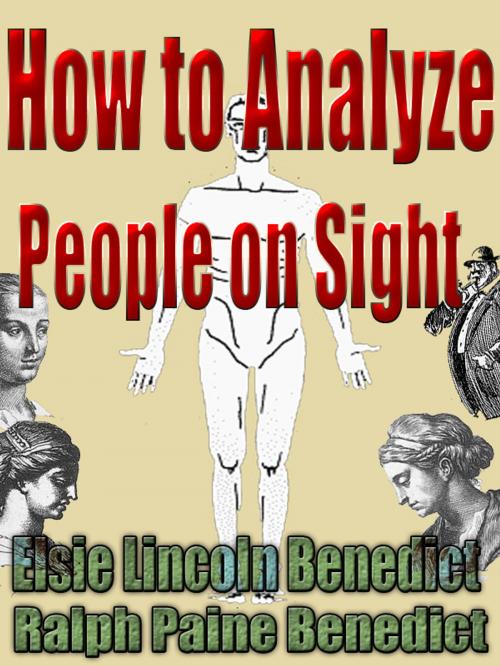How to Analyze People on Sight
Through the Science of Human Analysis: The Five Human Types
Nonfiction, Family & Relationships, Relationships, Friendship, Education, Interpersonal Relationships| Author: | Elsie Lincoln Benedict, Ralph Paine Benedict | ISBN: | 1230000033543 |
| Publisher: | Higs Publishing | Publication: | November 25, 2012 |
| Imprint: | Language: | English |
| Author: | Elsie Lincoln Benedict, Ralph Paine Benedict |
| ISBN: | 1230000033543 |
| Publisher: | Higs Publishing |
| Publication: | November 25, 2012 |
| Imprint: | |
| Language: | English |
These excerpts from almost 100 years old book will help improve your skill of reading people. How to Analyze People on Sight was written by Elsie Lincoln Benedict and Ralph Paine Benedict in 1921. Read on and see if their theories are still applicable today. The authors wrote:
Modern science has proved that the fundamental traits of every individual are indelibly stamped in the shape of his body, head, face and hands—an X-ray by which you can read the characteristics of any person on sight.
The most essential thing in the world to any individual is to understand himself. The next is to understand the other fellow. For life is largely a problem of running your own car as it was built to be run, plus getting along with the other drivers on the highway.
From this book you are going to learn which type of car you are and the main reasons why you have not been getting the maximum of service out of yourself.
Also you are going to learn the makes of other human cars, and how to get the maximum of co-operation out of them. This co-operation is vital to happiness and success. We come in contact with our fellowman in all the activities of our lives and what we get out of life depends, to an astounding degree, on our relations with him.
Reaction to Environment
The greatest problem facing any organism is successful reaction to its environment. Environment, speaking scientifically, is the sum total of your experiences. In plain United States, this means fitting vocationally, socially and maritally into the place where you are.
If you don't fit you must move or change your environment to fit you. If you can't change the environment and you won't move you will become a failure, just as tropical plants fail when transplanted to the Nevada desert.
Learn From the Sagebrush
But there is something that grows and keeps on growing in the Nevada desert—the sagebrush. It couldn't move away and it couldn't change its waterless environment, so it did what you and I must do if we expect to succeed. It adapted itself to its environment, and there it stands, each little stalwart shrub a reminder of what even a plant can do when it tries!
Moving Won't Help Much
Human life faces the same alternatives that confront all other forms of life—of adapting itself to the conditions under which it must live or becoming extinct. You have an advantage over the sagebrush in that you can move from your city or state or country to another, but after all that is not much of an advantage. For though you may improve your situation slightly you will still find that in any civilized country the main elements of your problem are the same.
Understand Yourself and Others
So long as you live in a civilized or thickly populated community you will still need to understand your own nature and the natures of other people. No matter what you desire of life, other people's aims, ambitions and activities constitute vital obstructions along your pathway. You will never get far without the co-operation, confidence and comradeship of other men and women.
These excerpts from almost 100 years old book will help improve your skill of reading people. How to Analyze People on Sight was written by Elsie Lincoln Benedict and Ralph Paine Benedict in 1921. Read on and see if their theories are still applicable today. The authors wrote:
Modern science has proved that the fundamental traits of every individual are indelibly stamped in the shape of his body, head, face and hands—an X-ray by which you can read the characteristics of any person on sight.
The most essential thing in the world to any individual is to understand himself. The next is to understand the other fellow. For life is largely a problem of running your own car as it was built to be run, plus getting along with the other drivers on the highway.
From this book you are going to learn which type of car you are and the main reasons why you have not been getting the maximum of service out of yourself.
Also you are going to learn the makes of other human cars, and how to get the maximum of co-operation out of them. This co-operation is vital to happiness and success. We come in contact with our fellowman in all the activities of our lives and what we get out of life depends, to an astounding degree, on our relations with him.
Reaction to Environment
The greatest problem facing any organism is successful reaction to its environment. Environment, speaking scientifically, is the sum total of your experiences. In plain United States, this means fitting vocationally, socially and maritally into the place where you are.
If you don't fit you must move or change your environment to fit you. If you can't change the environment and you won't move you will become a failure, just as tropical plants fail when transplanted to the Nevada desert.
Learn From the Sagebrush
But there is something that grows and keeps on growing in the Nevada desert—the sagebrush. It couldn't move away and it couldn't change its waterless environment, so it did what you and I must do if we expect to succeed. It adapted itself to its environment, and there it stands, each little stalwart shrub a reminder of what even a plant can do when it tries!
Moving Won't Help Much
Human life faces the same alternatives that confront all other forms of life—of adapting itself to the conditions under which it must live or becoming extinct. You have an advantage over the sagebrush in that you can move from your city or state or country to another, but after all that is not much of an advantage. For though you may improve your situation slightly you will still find that in any civilized country the main elements of your problem are the same.
Understand Yourself and Others
So long as you live in a civilized or thickly populated community you will still need to understand your own nature and the natures of other people. No matter what you desire of life, other people's aims, ambitions and activities constitute vital obstructions along your pathway. You will never get far without the co-operation, confidence and comradeship of other men and women.















